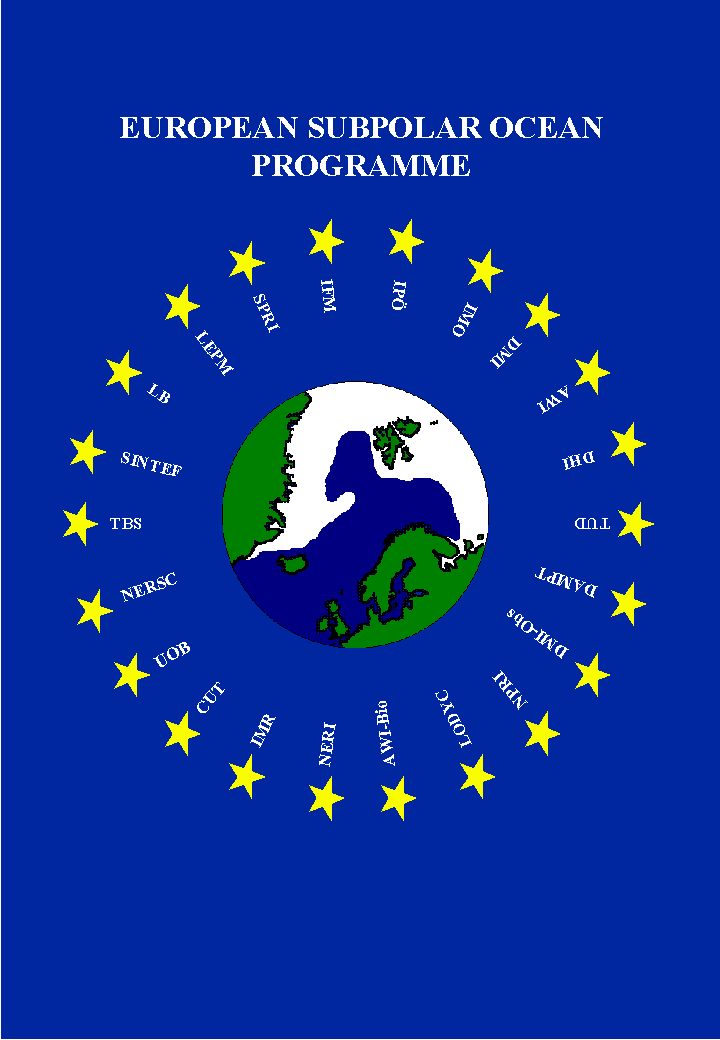ESOP
European Subpolar Ocean Project under MAST-II

Note: ESOP-2 project now underway,
visit the DCRS ESOP-2 pages
Overall project description
The European Subpolar Ocean Project (ESOP) has the overall objective of understanding
the role played by sea ice in the energetics of the Greenland Sea system as a
whole, and in the specific ice-ocean interactions involved in the process of deep
convection in the winter in the Greenland Sea with its attendant sequestration
of carbon dioxide. Work began in July 1993, and will continue for three years,
with 22 participating principal investigators
from 7 countries of or associated with the European Union (Denmark, France,
Germany, Great Britain, Iceland, Norway, Sweden). The project is funded by the
Commission of the European Union under the Marine Science and Technology Programme
(MAST-II), contract no. MAS2-CT93-0057.
Role and contribution of TUD (DCRS)
Ice formation and decay in the Odden area
High resolution (30-100 meters) synthetic aperture radar (SAR) data will
be used to study the small scale formation and decay of ice in the Odden
area. The images will be classified into various types of ice based on
the statistics (texture) of pixel values inside regions. The ice motion
field will primarily be derived from thermal infrared and near infrared
images from the NOAA AVHRR (Advanced Very High Resolution Radiometer, 1
kilometre resolution) during cloud-free periods. These observations will
be supplemented by observations made with SAR data when the area is cloud
covered and/or where the very high resolution is necessary in order to
distinguish individual features. A report on the Odden/Bay area of the
1993 winter is available on-line. It includes a large number of ERS-1 SAR
and ssm/i passive microwave images of the Greenland Sea.
Daily large scale ice maps
Most recent SSM/I derived ice concentrations in the Greenland Sea area
Shorter intervals between observations will be obtained by using
data from passive microwave radiometers. These data have a spatial resolution
of 10-30 kilometres and thus allow only large-scale studies. However, the
swath of the sensor is almost 1400 kilometres allowing observations of
the Odden region 2-4 times every 24 hours. The data can be used to derive
ice concentrations and potentially distinguish between a few ice types.
However, absolute calibration is a problem and requires an independent
set of observations. It is the intention to use the ice information derived
from the SAR data and AVHRR (VALEUR) to perform this calibration. The passive
microwave data will be used to provide operational ice maps in collaboration
with VALEUR if the data becomes available in near real-time
Sea ice signatures
In order to further understand the microwave signatures from various ice
types it is proposed to carry out a field experiment in conjunction with
the winter 1993 cruise by Polarstern. A trained ice observer will be on
board the ship to collect samples of ice and snow whenever the ship is
stationary (collecting oceanographic data). Also, an aircraft equipped
with instruments similar to the satellite instruments will be operated.
The aircraft instruments will have a much better spatial resolution (50-200
meters) than the satellite instruments, allowing a more detailed comparison
of passive microwave data, SAR data and surface observations.
Historical perspective
A large historical record of satellite-based passive microwave observations
exists, dating back to 1973. It is proposed to analyze this dataset in
order to obtain a basis for evaluating the data collected during the one-year
field experiment in 1993. The analysis will be performed using established
methods (Pedersen, 1991) for calibrating the derived ice concentrations
based on areas of stable ice conditions and additional visible and infrared
high resolution imagery from cloud-free periods.
 Provisional results are available by clicking on the bargraph.
Provisional results are available by clicking on the bargraph.
A number of MPEG encoded animations of previous years ice conditions
in the odden area is under construction and may be found by clicking on
the colourfull icon below.

Project related data
Ice
in the Odden area January and February 1993
Sattellite Observations
of the Odden Ice Cover during the Winter of 1995-1996
Preliminary
report on SSM/I algorithm comparison
Ice edge positions at 75N, 1992-1995
Daily gif images
from the Greenland Sea, 1993-1997
Leif Toudal <ltp@emi.dtu.dk>
Last modified: Wed Aug 21 10:03:43 1996


 Provisional results are available by clicking on the bargraph.
Provisional results are available by clicking on the bargraph.